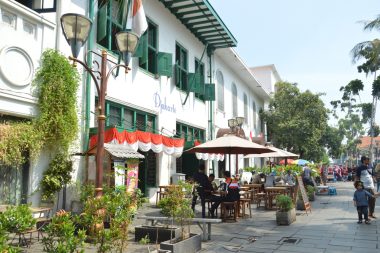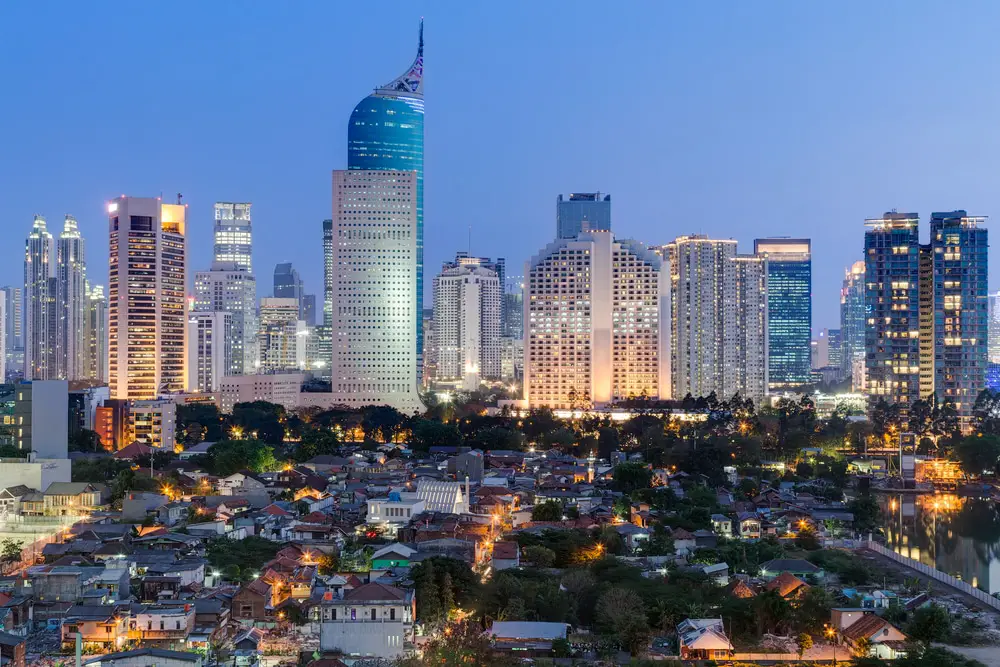Colorful, loud and hectic – this is the economic, cultural and political center of Indonesia. It is not for nothing that Jakarta is named by its inhabitants after the regional stinky fruit “Big Durian” with a wink, based on the New York “Big Apple”. Those who travel to the metropolis of millions do not come here to relax, but to get to know the country and its people.
Hectic traffic
Soekarno-Hatta International Airport is the largest transport hub and is located about 20 km outside the city. If you want to get around by public transport and are not afraid of contact with locals and longer waiting times due to unforeseeable cancellations, take the regional train. For everyone else, the bus or the numerous, relatively cheap taxis are advised.
Cultural attractions

The attraction for tourists is the small old town called Kota. It impresses with its buildings, which date back to the colonial era. There are also several museums in the vicinity. The Jakarta History Museum displays archaeological finds as well as furniture and weapons from the colonization period. Right next to it is the Wayang Museum, which focuses on Indonesian puppet theatre.
From there, a short walk along the Great Canal leads to the old Hühnermarkt Bridge. The bridge, which is over 200 years old, is the last drawbridge of its kind. Once you arrive at the mouth of the canal, you reach a beautiful observation tower that offers a view over the sailing harbour “Sund Kelapa”. If you want to overlook the whole city from above, you should not miss the national monument “Monas” on Independence Square. The tower, which is over 130 meters high, offers a viewing platform whose view gives an idea of the full extent of this city.
Exotic cuisine
Visitors to Jakarta can draw on culinary delights. Indonesia has an almost inexhaustible wealth of traditional dishes and culinary delights. On every corner, exotic scents lure you to the mobile food stalls of the locals, who conjure up delicious dishes with the simplest of means. Jakarta also has a wide range of restaurants to offer. Apart from the local cuisine, there are many good Chinese and Indian restaurants. And if you can’t do without your Kassel beer on holiday, you’ll find that yourself in the German Beer Garden.
Enjoyable cooling

Jakarta is a melting pot in the truest sense of the word. It rarely has less than 20 degrees here at night. Frequent rain causes sultry heat throughout the year. The amusement park “Taman Impian Jaya Ancol” in the north of the city promises cooling and fun. Located directly on the sea, it offers not only water fun, but also its own gondola, an aquarium including shark tank and glass tunnels, a bowling alley and a golf course. Children have a special time in the “Dunia Fantasi”, a classic fairground with a carousel, Ferris wheel and roller coaster. A special highlight, however, is the theme park “Taman Mini Indonesia Indah”. Here, typical Indonesian huts have been rebuilt in miniature around a lake, giving an impression of old Indonesia. A gondola lift leads above it, allowing a bird’s-eye view.
Animal exotics
Animal lovers who want to escape the noise of the big city and enjoy some peace and nature are drawn to the Ragunan Zoo in the south of the city. More than 400 exotic animal species – such as Sumatran tigers, Komodo dragons and orangutans – are at home here and give an insight into the local fauna and flora.
Idyllic island hopping
Even quieter and more idyllic than in the zoo is the peace and quiet by the sea. Starting from the bay of Jakarta, you can take a speedboat to the marine national park. “Kepulauan Seribu” – the thousand islands – is what the locals call this area of sand, sea and rocks, which is known for its coral reefs. Island hopping is particularly popular here – you will find numerous attractions such as ruins, fortresses, a shipwreck, dolphin shows, a turtle breeding station, as well as numerous restaurants and hotels.
Jakarta is sinking – The downfall of a metropolis
But the idyll is deceptive. Jakarta is slowly but inexorably sinking. The sea level is rising steadily. Officially, about 10 million people live in the urban area of the Big Durian alone. If you count the surrounding regions, there are about three times as many. The city is hopelessly overcrowded. There is no reliable supply of water. Only about half of households in Jakarta are connected to the public grid. All others pump the water out of the ground themselves, thus ensuring that the soil slowly subsides. The enormous population density and the problems that come with it, as well as climate change, have prompted the government to make a drastic decision. The country’s capital is being moved. No new capital has yet been chosen. The island of Borneo is being discussed, as there is a lower risk of volcanic eruptions and earthquakes here.
If you want to visit Jakarta, you shouldn’t put it off for too long. Because who knows how long Big Durian will continue to exist in this form.
The most important facts about Jakarta
Geography
Located on the northwest coast of the island of Java, Jakarta is one of the most densely populated cities in the world. The city covers an area of about 662 square kilometers and is crossed by several rivers that flow into Jakarta Bay.
Climate
Jakarta experiences a tropical climate, with two main seasons: the rainy season and the dry season. The rainy season lasts from November to March and the dry season from June to September. Temperatures remain relatively constant throughout the year, with averages between 25 and 30 degrees Celsius.
Culture and sights
Jakarta is a melting pot of different cultures and ethnicities, which is evident in the diversity of languages, traditions and celebrations. Cultural highlights include:
- Taman Mini Indonesia Indah: A cultural park that represents the different regions of Indonesia.
- National Museum: Provides insight into Indonesia’s rich history.
- Monas (National Monument): A 132-meter-high tower commemorating Indonesia’s independence.
- Istiqlal Mosque: The largest mosque in Southeast Asia.
Gastronomy
Jakarta’s cuisine is a reflection of the city’s ethnic diversity. Popular local dishes include:
- Nasi Goreng: Fried rice, often served with vegetables, chicken, or seafood.
- Sate: Grilled meat skewers served with a variety of sauces.
- Gado-Gado: An Indonesian salad of boiled vegetables with peanut sauce.
Traffic
Jakarta is known for its dense and often congested transportation system. In addition to the extensive network of bus routes, there is also an evolving system of mass rapid transit (MRT) and light rail (LRT) to improve mobility.
Economy
As the economic heart of Indonesia, Jakarta is home to numerous national and international companies. The city plays a central role in trade, industry and the service sector.
Events
Jakarta offers numerous events throughout the year, including art exhibitions, music festivals, and cultural celebrations. A highlight is the Jakarta International Java Jazz Festival, which annually attracts music lovers from all over the world.
The climate in Jakarta
| Month | Average maximum temperature (°C) | Average low temperature (°C) | Average rainfall (mm) |
|---|---|---|---|
| January | 30 | 24 | 300 |
| February | 30 | 24 | 270 |
| March | 31 | 24 | 210 |
| April | 32 | 25 | 150 |
| May | 32 | 25 | 140 |
| June | 31 | 24 | 100 |
| July | 31 | 23 | 60 |
| August | 31 | 23 | 50 |
| September | 32 | 24 | 70 |
| October | 32 | 24 | 110 |
| November | 31 | 24 | 180 |
| December | 30 | 24 | 210 |


